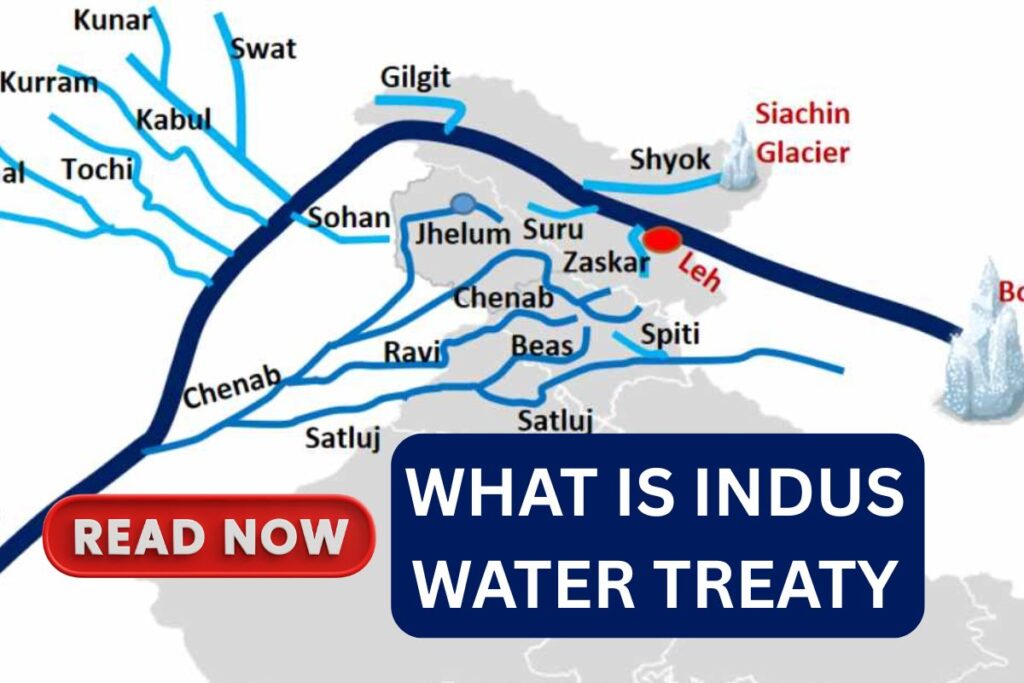The Indus Waters Treaty, which has crossed four wars, decades of Pakistani cross-border terrorism against India and history of Hostility. India made the suspension of the Indus Water Treaty a day following the Pahalgam tourist attack by the Terrorists, in which 26 people were slain by Pakistani militants. We have briefly explained the Clauses Of Indus Water Treaty which you can read to understand better. The New Sanction on the Indus Water Treaty After Pahalgam Tourist Attack 2025 might have the most significant effects of the many diplomatic measures against Pakistan that India has taken, such as closing the border post in Attari, cancelling visas, and expelling some Pakistani employees from India.

What Is the Indus Water Treaty
In response to the terror assault in Pahalgam, India terminated the Indus Water Treaty with Pakistan on 23 April 2025. This action was one of five significant choices made during Prime Minister Narendra Modi’s Cabinet Committee on Security meeting. After nine years of negotiation between India and Pakistan, the IWT was signed in Karachi on September 19, 1960. There are twelve articles and eight annexes (A through H) in the treaty. The Treaty’s stipulations state that India will have “unrestricted use” of all the water from the Sutlej, Beas, and Ravi, the “Eastern Rivers” of the Indus system. The “Western Rivers”, the Indus, Chenab, and Jhelum, will supply water to Pakistan. The Indus River and its tributaries’ waters are divided between the two nations under the treaty.
Indus Water Treaty Agreement : Overview
| Treaty Name | Indus Water Treaty Agreement |
| Signed On | 19 September 1960 |
| Country Parties | India and Pakistan |
| Mediated By | World Bank |
| Effective Date | 1 April 1960 |
| Water Allocation | India: Ravi, Sutlej, and Beas (Eastern Rivers)Pakistan: Indus, Chenab, and Jhelum (Western Rivers) |
| Category | News |
Clauses Of Indus Water Treaty
The World Bank served as a guarantee for the 1960 water-sharing pact between India and Pakistan, known as the Indus Water Treaty (IWT). The Clauses Of Indus Water Treaty include
- Water Allocation: The treaty gives India access to the waters of the Sutlej, Beas, and Ravi rivers in the east and Pakistan to the Indus, Jhelum, and Chenab rivers in the west.
- Permitted Uses: Pakistan has unlimited use of the western rivers’ waters, whereas India is permitted to use them for non-consumptive uses, including the production of hydroelectric power.
- Dispute Resolution: A Permanent Indus Commission, impartial experts, and the Court of Arbitration are among the mechanisms for settling disagreements between the two nations that are established by the treaty.
New Sanction on the Indus Water Treaty After Pahalgam Tourist Attack 2025
New sanctions have been placed on the Indus Water Treaty by India in response to the Pahalgam tourist attack. These are the main New Sanction on the Indus Water Treaty After Pahalgam Tourist Attack 2025:
- Indus Waters Treaty Temporary Suspension: Citing Pakistan’s ongoing support for cross-border terrorism, India has temporarily suspended the treaty with immediate effect. The CCS (Cabinet Committee on Security) met and decided on this course of action.
- Integrated Check Station Closure: The Attari-Wagah Border integrated check station is no longer located there.
- Travel Prohibition for Pakistani Nationals: All Pakistani nationals can no longer travel to India under the SAARC Visa Exemption Scheme, and all previously issued visas will be revoked.
- Removal of Pakistani Military Advisors: Indian military advisors in Islamabad were removed, and Pakistani military advisors in the Pakistan High Commission in New Delhi were kicked out. There are also fewer staff members at the Indian High Commission in Islamabad.
SITUATION: The Pahalgam incident, which claimed the lives of at least 28 tourists and injured more than 20, prompted the suspension. Citing Pakistan’s resistance and rising water demands as a result of demographic shifts, India has been attempting to amend the pact since January 2023.
Effects Of the Indus Water Treaty On Both India and Pakistan
Pakistan and India have both been significantly impacted by the IWT. Despite continuing conflicts, the treaty has given both nations some degree of water security. Pakistan has benefited from the western rivers’ hydroelectric potential, whereas India has been able to utilise the eastern rivers’ capacity.
- Water Security: The treaty has ensured a degree of water security for both countries, despite ongoing tensions.
- Hydroelectric Power: India has been able to harness the hydropower potential of the eastern rivers, while Pakistan has benefited from the western rivers.
- Agricultural Development: The treaty has facilitated agricultural development in both countries by providing a stable water supply.
- Tensions and Disputes: Despite its benefits, the treaty has been a source of tension between India and Pakistan, with disputes arising over issues like water sharing and infrastructure projects
Both nations are striving to implement the IWT’s terms while tackling new issues, making it a vital component of India-Pakistan relations.
FAQs On the Indus Water Treaty
What is the Water Treaty of the Indus?
The 1960 water-sharing pact between India and Pakistan regulates the usage of the waters of the Indus River system.
What are the most important clauses?
The treaty states that India will receive the Ravi, Sutlej, and Beas (Eastern Rivers) and Pakistan will receive the Indus, Chenab, and Jhelum (Western Rivers).
Why does the treaty matter?
It guarantees both nations’ water security, fosters collaboration, and settles disagreements over water distribution.



